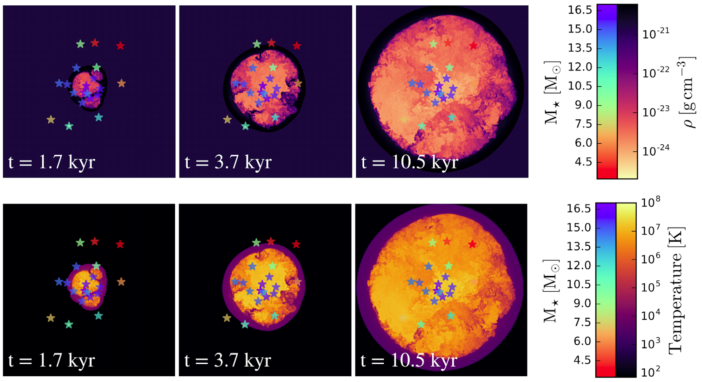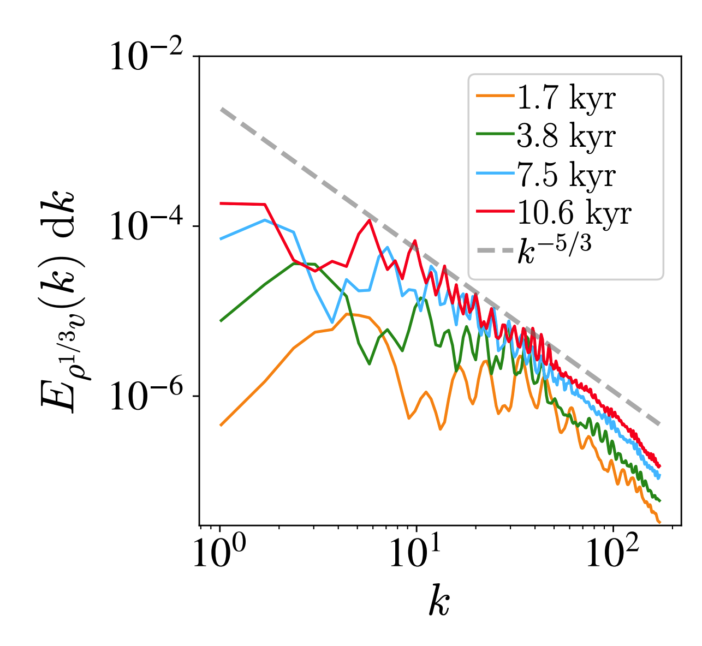Editor’s note: Astrobites is a graduate-student-run organization that digests astrophysical literature for undergraduate students. As part of the partnership between the AAS and astrobites, we occasionally repost astrobites content here at AAS Nova. We hope you enjoy this post from astrobites; the original can be viewed at astrobites.org.
Title: Winds in Star Clusters Drive Kolmogorov Turbulence
Authors: Monica Gallegos-Garcia, Blakesley Burkhart, Anna Rosen, Jill P. Naiman, and Enrico Ramirez-Ruiz
First Author’s Institution: Northwestern University
Status: Published in ApJL
Turbulence, or chaotic changes in the pressure and velocity of a fluid, is one of the great mysteries of classical physics. Much of the gas in galaxies is known to be turbulent, but the mechanisms that developed and maintain this turbulence remain areas of active research. While we still don’t know all the details of the physics behind turbulence, a lot of time and effort has gone into identifying statistics that can tell us whether gas is turbulent or not. In other words, we know what turbulence looks like even if we don’t know all the details of how it works (see this Youtube video for a great introduction to turbulence and the power spectrum, a statistic used in today’s paper). Today’s weather forecast calls for strong winds blowing in from the arXiv as we explore a new paper studying how stellar winds from star clusters can drive such turbulence.
Stellar winds, particularly those from massive stars like O or B types, blow bubbles in the surrounding cold gas by pushing it outwards and leaving a cavity behind. These are analogous to the bubbles we see on Earth that are created by air pushing into some other medium. In the case of a stellar-wind bubble, the “air” is hot stellar wind material. When massive stars are found in a star cluster, their bubbles tend to overlap and form a “superbubble”. One incredible example of this is the Orion Nebula Cluster (see the cover image above). The authors of today’s paper run simulations that roughly mimic the stellar profile of the Orion Nebula Cluster, and they too find the creation of large superbubble.
In these simulations, the most massive stars expel high-velocity, hot gas that fills the superbubble and pushes it outwards into cooler gas. This expansion produces a thick shell at an intermediate temperature (Figure 1). Because this shell is more dense than the central hot gas, it is able to cool faster and remain much cooler than the superbubble interior. As the simulations progress, turbulent instabilities appear in the hot gas inside the shell.

Figure 1: Plots of the expanding superbubble created by winds from massive stars. The most massive stars are shown in blue and purple, and these are the ones that primarily contribute to the bubble expansion. Top: Density slice, with high-density material shown in darker colors and low-density material shown in lighter colors. Bottom: Temperature slice, with hotter material shown in lighter colors and cooler material shown in darker colors. Time is shown in kyr (1 kyr = 1,000 years). [Gallegos-Garcia et al. 2020]

Figure 2: Plots of gas velocities in the expanding superbubble. The mass of the stars is denoted the same way as before. The Mach number is shown as a logarithm, meaning that negative numbers correspond to a Mach number less than one, zero corresponds to a Mach number of one, and positive numbers correspond to a Mach number greater than one. Time is shown in kyr (1 kyr = 1,000 years). [Gallegos-Garcia et al. 2020]

Figure 3: Density-weighted velocity power spectrum for different times in the simulation. The dashed line indicates the expectation for subsonic turbulence. The y-axis shows the power spectrum, and the x-axis denotes the wavenumber. See this video for an explanation of the power spectrum. [Gallegos-Garcia et al. 2020]
About the author, Michael Foley:
I’m a graduate student studying Astrophysics at Harvard University. My research focuses on using simulations and observations to study stellar feedback — the effects of the light and matter ejected by stars into their surroundings. I’m interested in learning how these effects can influence further star and galaxy formation and evolution. Outside of research, I’m really passionate about education, music, and free food.


2 Comments
Pingback: Wietrzny dzień w Drodze Mlecznej – PTMA Kraków
Pingback: Wietrzny dzień w Drodze Mlecznej – Astronomia Śląska